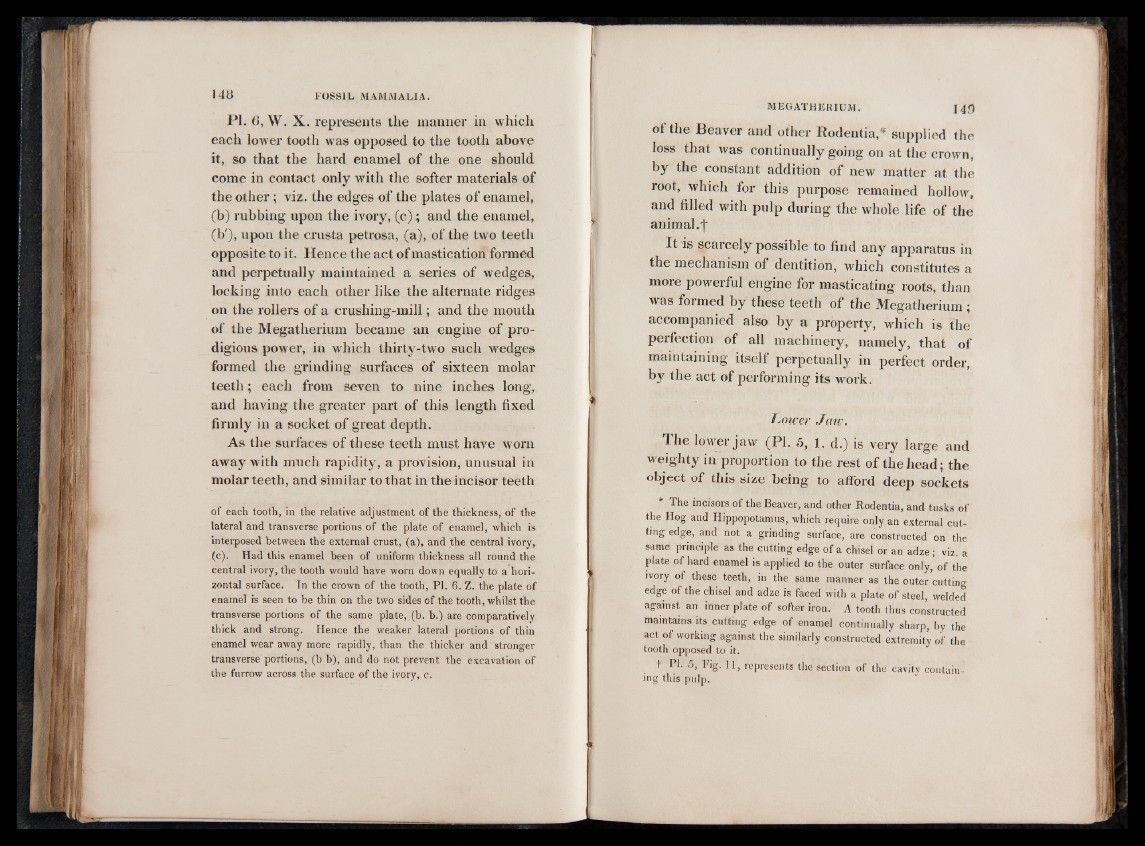
P1. 6 , W. X. represents the manner in which
each lower tooth was opposed to the tooth above
it, so that the hard enamel of the one should
come in contact only with the softer materials of
the other; viz. the edges of the plates of enamel,
(b) rubbing upon the ivory, (c); and the enamel,
(b'), upon the crusta petrosa, (a), of the two teeth
opposite to it. Hence the act of mastication formed
and perpetually maintained a series of wedges,
locking into each other like the alternate ridges
on the rollers of a crushing-mill; and the mouth
of the Megatherium became an engine of prodigious
power, in which thirty-two such wedges
formed the grinding surfaces of sixteen molar
teeth; each from seven to nine inches long,
and having the greater part of this length fixed
firmly in a socket of great depth.
As the surfaces of these teeth must have worn
away with much rapidity, a provision, unusual in
molar teeth, and similar to that in the incisor teeth
of each tooth, in the relative adjustment of the thickness, of the
lateral and transverse portions of the plate of enamel, which is
interposed between the external crust, (a), and the central ivory,
(c) . Had this enamel been of uniform thickness all round the
central ivory, the tooth would have worn down equally to a horizontal
surface. In the crown of the tooth, PI. 6. Z. the plate of
enamel is seen to be thin on the two sides of the tooth, whilst the
transverse portions of the same plate, (b. b.) are comparatively
thick and strong. Hence the weaker lateral portions of thin
enamel wear away more rapidly, than the thicker and stronger
transverse portions, (b b), and do not prevent the excavation of
the furrow across the surface of the ivory, c.
MEGATHERIUM. 14.0
of the Beaver and other Rodentia,* supplied the
loss that was continually going on at the crown,
by the constant addition of new matter at the
root, which for this purpose remained hollow,
and filled with pulp during the whole life of the
animal, t
It is scarcely possible to find any apparatus in
the mechanism of dentition, which constitutes a
more powerful engine for masticating roots, than
was formed by these teeth of the Megatherium ;
accompanied also by a property, which is the
perfection of all machinery, namely, that of
maintaining itself perpetually in perfect order,
by the act of performing its work.
Lower Jaw.
The lower jaw (PI. 5, 1 . d.) is very large and
weighty in proportion to the rest of the head; the
object of this size being to afford deep sockets
* The incisors of the Beaver, and other Rodentia, and tusks of
the Hog and Hippopotamus, which require only an external cutting
edge, and not a grinding surface, are constructed on the
same principle as the cutting edge of a chisel or an adze; viz. a
plate of hard enamel is applied to the outer surface only,’ of the
ivory of these teeth, in the same manner as the outer cutting
edge of the chisel and adze is faced with a plate of steel, welded
against an inner plate of softer iron. A tooth thus constructed
maintains its cutting edge of enamel continually sharp, by the
act of working against the similarly constructed extremity of the
tooth opposed to it.
t PI- 5, Fig. 11, represents the section of the cavity containing
this pulp.